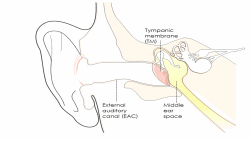Otitis media, or ear infection, is as common in kids as scraped knees, but it's a lot more difficult to treat, usually requiring a long course of antibiotics.
Daniel Kohane, a doctor at Boston Children’s Hospital, compared force-feeding antibiotics to children to full-contact wrestling. So, working at the Laboratory for Biomaterials and Drug Delivery at the Massachusetts Institute of Technology, he developed an antibiotic-infused gel to treat and cure ear infections with a single application.
Kohane said a clinician can squirt the gel into the child’s ear during a single visit to the doctor. The gel forms a hardened plug, and the active ingredients are able to pass through the tympanic membrane, or eardrum, to treat the infection where it is needed.
Kohane said skeptical scientific researchers never thought it was possible to get the antibiotic past the eardrum. But the gel contains chemical permeation enhancers, compounds that have already received regulatory approval for other uses. Known as CPEs, they are structurally similar to lipids or fat molecules in the stratum corneum, the eardrum’s outermost layer. The CPEs insert themselves into the membrane, opening up molecular pores that allow the antibiotics to seep through.
Kohane said the ear gel causes fewer side effects than antibiotics.
“I previously spoke about the convenience that this gives the parents," he told VOA, "but the other thing to understand is that current therapy is an oral regimen of 10 days. So when you take a drug orally, the drug has to go throughout the body to treat a really small piece of real estate inside the head. The entire body gets exposed to antibiotic, and this leads to a number of side effects, like diarrhea, rashes and things like that.”
Antibiotic resistance
In addition to side effects, there is the problem of antibiotic resistance. When a child starts to feel better in a few days, parents may stop trying to medicate a squirming child, creating stronger bacteria and harder-to-treat infections.
The ear gel was tested in chinchillas, which were used because they have an ear structure and hearing range similar to those of people.
The gel dispensed high concentrations of the antibiotic ciprofloxacin in the middle ear and completely cured ear infections caused by Haemophilus influenzae in 10 of 10 animals. Ordinary ciprofloxacin eardrops cured the infection in only five of eight chinchillas.
Researchers said there were no side effects beyond a slight, temporary hearing loss, like that caused by earwax. The problem could be solved, they said, by squirting less gel into the ear.
An article describing the ear gel was published in the journal Science Translational Medicine. Kohane’s associate, Rong Yang, said she was surprised by comments from the paper’s reviewers at the journal.
“They referred to this technology that we developed as exciting, innovative, unique, impressive, close to ideal, much-needed,” said Yang.
Kohane added, "One reviewer asked us to change a comma. That was the sum total of the constructive criticism.”
The next step is human clinical trials, which can’t come too soon for many parents.





